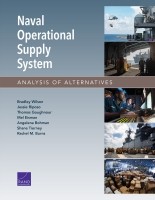| 来源类型 | Research Reports
|
| 规范类型 | 报告
|
| DOI | https://doi.org/10.7249/RR2403
|
| 来源ID | RR-2403-NAVY
|
| Naval Operational Supply System: Analysis of Alternatives |
| Bradley Wilson; Jessie Riposo; Thomas Goughnour; Mel Eisman; Angelena Bohman; Shane Tierney; Rachel M. Burns
|
| 发表日期 | 2018
|
| 出版年 | 2018
|
| 页码 | 59
|
| 语种 | 英语
|
| 结论 |
Commercial-off-the-shelf software is the best choice for going forward- The AoA specified four alternative areas — Status Quo, Commercial-Off-the-Shelf (COTS), Government-Off-the-Shelf (GOTS), and Hybrid (some combination of the other three) — and examined nine possible alternative options.
- The Navy has several viable options, with Alternatives 3 (COTS), 8 (Hybrid Optimize Commercial with Status Quo of Food Service Management and Retail Operations Management systems), and 9 (Hybrid Forward Compatible Commercial) offering the best performance and the lowest cost, schedule, and performance risks. Within the COTS alternative, there are many potential providers.
- The risk-adjusted cost estimates for the COTS alternatives (3, 8, and 9) vary significantly. The higher estimates are nearly twice the cost of the lower estimates, with a spread of more than $200 million. This cost range reflects risk and the variety of integrators and vendors available.
|
| 摘要 |
- The Navy should move forward with COTS, with a preference for Alternative 9 (Hybrid Forward Compatible Commercial).
- The Navy has options to manage the risks of choosing any alternative. For example, the Navy can minimize risk by prototyping. Furthermore, ensuring that the requirements are achievable without significant customization can also minimize risk.
- The Navy should become more agile and mitigate the large number of detailed requirements through prioritization and contractual flexibility that enables the Navy, software provider, and integrator to agree on requirements changes. Ten thousand detailed-level requirements, with many of those functional in nature and lacking specification of quality attributes, could be problematic. Burdensome numbers of requirements and lack of specificity in quality attributes were two reasons why a previous attempt to modernize naval supply had problems staying on budget and schedule and, ultimately, failed.
|
| 主题 | Combat Service Support
; Military Acquisition and Procurement
; Military Information Technology Systems
; Military Ships and Naval Vessels
; Supply Chain Management
; United States Navy
|
| URL | https://www.rand.org/pubs/research_reports/RR2403.html
|
| 来源智库 | RAND Corporation (United States)
|
| 引用统计 |
|
| 资源类型 | 智库出版物
|
| 条目标识符 | http://119.78.100.153/handle/2XGU8XDN/108887
|
推荐引用方式
GB/T 7714 |
Bradley Wilson,Jessie Riposo,Thomas Goughnour,et al. Naval Operational Supply System: Analysis of Alternatives. 2018.
|
|
文件名:
|
x1540468312564.jpg
|
|
格式:
|
JPEG
|

|
文件名:
|
RAND_RR2403.pdf
|
|
格式:
|
Adobe PDF
|
除非特别说明,本系统中所有内容都受版权保护,并保留所有权利。